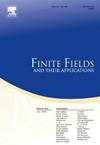Cyclically covering subspaces of Fqn
IF 1.2
3区 数学
Q1 MATHEMATICS
引用次数: 0
Abstract
Let q be a prime power, n be a positive integer, and be the n-dimensional row vector space over finite field . We say a subspace U of is cyclically covering if the union of the cyclic shifts of U is equal to . Recently, the largest possible codimension of a cyclically covering subspace of , denoted by , has attracted the attention of many scholars. In this paper, we introduce cyclically covering subspaces of finite field . By virtue of the theory of direct sum decomposition of finite fields, we describe a method for constructing cyclically covering subspaces of , and determine the value of for some special n. In particular, we prove . Finally, several lower bounds of are given when , which generalizes results of the existing results in [2].
循环覆盖Fqn的子空间
设q是素数幂,n是正整数,Fqn是有限域Fq上的n维行向量空间。我们说Fqn的子空间U是循环覆盖的如果U的循环移位的并集等于Fqn。近年来,Fqn的一个循环覆盖子空间的最大可能余维,用hq(n)表示,引起了许多学者的关注。本文引入有限域Fqn的循环覆盖子空间。利用有限域的直接和分解理论,给出了构造Fqn的循环覆盖子空间的一种方法,并对某些特殊的n确定了h2(n)的值,特别证明了h2(21)=4。最后给出了(q,n)=1时hq(n)的几个下界,推广了[2]中已有的结果。
本文章由计算机程序翻译,如有差异,请以英文原文为准。
求助全文
约1分钟内获得全文
求助全文
来源期刊
CiteScore
2.00
自引率
20.00%
发文量
133
审稿时长
6-12 weeks
期刊介绍:
Finite Fields and Their Applications is a peer-reviewed technical journal publishing papers in finite field theory as well as in applications of finite fields. As a result of applications in a wide variety of areas, finite fields are increasingly important in several areas of mathematics, including linear and abstract algebra, number theory and algebraic geometry, as well as in computer science, statistics, information theory, and engineering.
For cohesion, and because so many applications rely on various theoretical properties of finite fields, it is essential that there be a core of high-quality papers on theoretical aspects. In addition, since much of the vitality of the area comes from computational problems, the journal publishes papers on computational aspects of finite fields as well as on algorithms and complexity of finite field-related methods.
The journal also publishes papers in various applications including, but not limited to, algebraic coding theory, cryptology, combinatorial design theory, pseudorandom number generation, and linear recurring sequences. There are other areas of application to be included, but the important point is that finite fields play a nontrivial role in the theory, application, or algorithm.

 求助内容:
求助内容: 应助结果提醒方式:
应助结果提醒方式:


